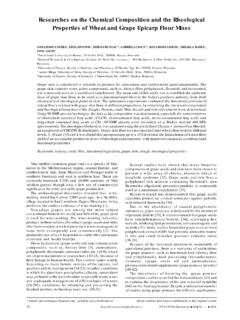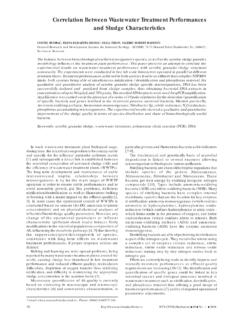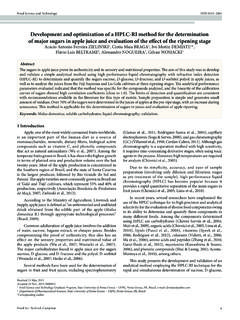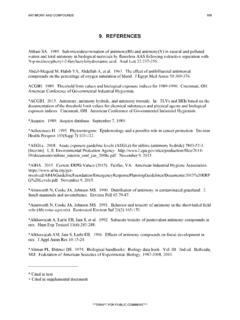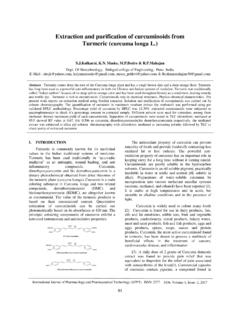Transcription of Simultaneous Determination of Anionic, …
1 (Bucharest) 69 No. 1 2018 Determination of anionic , Amphotericand cationic Surfactants mixtures in Surface WaterIULIANA PAUN*, VASILE ION IANCU, LILIANA CRUCERU, MARCELA NICULESCU, FLORENTINA LAURA CHIRIACN ational Research and Development Institute for Industrial Ecology ECOIND, 71-73 Drumul Podu Dambovitei Str., 060652,Bucharest, RomaniaA simple, reliable and accurate HPLC/CAD method was developed for the Determination of anionic (sodiumdioctyl sulfosuccinate and sodium 1-dodecane sulfonate), amphoteric (CHAPS (3-[(3-Cholamidopropyl)dimethylammonium] -1-propanesulfonate hydrate)) and cationic (benzethonium chloride) surfactantsmixture from surface water samples. The chromatographic analysis was performed on an Acclaim SurfactantPlus (150 x mm, 3 m ) column acquired from Thermo Scientific, kept at 300C. All experiments wereperformed in gradient elution conditions at a flow-rate of mL/min. Mobile phase composition was amixture of acetonitrile (A) and M ammonium acetate solution acidified to pH 5 with acetic acid (B).
2 Thelimit of detection (LD) were 20 g/L for anionic surfactants and 30 g/L for cationic and amphotericsurfactants. The calibration curves were linear between 15 mg/L 110 mg/L, with R2 values above forall surfactants. Solid phase extraction (SPE) using polymeric (Strata X) cartridges has been applied toextract and concentrate the target analytes from the synthetic samples. Surfactants recoveries after SPEprocedure were situated between Intra-day and inter-day precision (RSD%) were situatedbetween and , respectively. Limit of quantitation (LQ) was lower than 80 g/L foranionic surfactants and 90 g/L for cationic and 100 g/L for amphoteric surfactants. The new sensitive andselective HPLC/CAD developed method allows Simultaneous Determination of anionic , amphoteric andcationic surfactants mixture from environmental samples (surface water).Keywords: HPLC/CAD, SPE, surfactant , surface waterIn industrial terminology, the word detergent issynonymous with surfactant .
3 More precisely, a detergentis a solid or liquid cleaning formulation that contains anumber of compounds, one or more of which is a surfactant [1]. Surfactants are found in the composition of a very largenumber of products. Among the most common aredomestic and industrial detergents, pharmaceuticals andcosmetics. They are also used for the solubilization commercial products are composed of more thantwo types of surfactant among four classes: Anionic, amphoteric , nonionic and cationic surfactants [2].Surfactants have an important role in the formation ofnanoparticles due to the packing offered by host surfactantassemblies. [3] anionic surfactants are widely use inproduction of detergent powders [4, 5].As the everyday increase in the production of surfactantand their usage, it has become necessary to monitor theirlevels and impact on different part of the into different ecosystems the surfactants aresubject to a variety of physical and chemical changes [6].
4 The analysis of surfactants involves a number of differentproblems arising from the specificity of this type of samplematrix and analytes (the presence of contaminants, lowlevel of surfactants, their diverse chemical structure, theamphiphilic nature of molecules, limited access to standardsolution and reference materials). Attempts to solve theseproblems involve the use of suitable extraction techniquesduring the preparation of environmental sample for analysis[7-9].The extraction techniques used to separate orpreconcentrate the surfactants from liquid environmentalsamples are: liquid-liquid extraction (LLE) and solid phaseextraction (SPE). The LLE technique uses high organic* email: consumption and results in toxic wastes while SPEis faster and needs lower sample and solvent volume. Forthe isolation of surfactants from environmental sampleswas used solid-phase extraction (SPE) [10-17].High-performance liquid chromatography (HPLC) iscurrently the most suitable method for the determinationof surfactants.
5 The major advantages of this analyticalmethod are its ability to separate various homologues,oligomers and isomers of complex surfactant mixturesand low detection limits obtained for both charged anduncharged HPLC analysis of surfactants mixtures , especiallyof various types, is well known to be very phase column RP-18 [12, 18, 19] and RP-8 [11,20] are used for chromatographic separation of Anionic, nonionic, cationic surfactants and their degradationproducts. surfactant classes which have chromophoregroups are determined by HPLC coupled to ultraviolet (UV)[21, 22] or fluorescence detectors [23, 24]. Because manysurfactants have low or no chromophore, universaldetector, such as Charged Aerosol Detector (CAD) andevaporative light scattering detector (ELSD) [3, 25], areoften aim of this work was the development andvalidation of a method using high performance liquidchromatography (HPLC) combined with charged aerosoldetector (CAD) for Simultaneous analysis of sodium dioctylsulfosuccinate ( anionic surfactant ), sodium 1- dodecanesulfonate ( anionic surfactant ), benzethonium chloride( cationic surfactant ) and CHAPS (3-[(3-Cholamidopropyl)dimethylammonium] -1-propane sulfonate hydrate, amphoteric surfactant ) in synthetic samples.
6 Chemicalstructures of these surfactants are shown in figure (Bucharest) 69 No. 1 201828 Experimental partReagents and standard solutionsHPLC grade water was obtained in house using a Milli-Q water purification system (Merck-Millipore). Sodium 1-dodecane sulfonate, sodium dioctyl sulfosuccinate andbenzethonium chloride were obtained from (3-[(3-Cholamidopropyl) dimethyl ammonium]-1-propanesulfonate hydrate), ammonium acetate, HPLC grade acetonitrile and methanol were purchased stock solutions were prepared by dissolving thesurfactants in methanol and bringing them to a final volumeof 10 mL with the same solvent. Stock standard solutionswere 110 mg/L of sodium 1- dodecane sulfonate, 80 mg/Lof sodium dioctyl sulfosuccinate, 92 mg/L benzethoniumchloride and 93 mg/L of CHAPS. The standard calibrationsolutions were made by dilution of the stock standardsolutions with mobile phase phase extraction procedureThe samples were treated with Dionex Autotrace 280automated solid-phase extraction apparatus (ThermoScientific).
7 The extraction applied to the surface watersample was applied to isolate the surfactants fromsamples. Solid phase extraction (SPE) was performed using a 6mL Strata-X (Phenomenex) cartridge packed with a 500mg sorbent. The cartridges were conditioned with 5 mL ofacetonitrile followed by 10 mL of ultra-pure water. Then,the 100 mL sample was loaded at a constant flow rate of2 mL/min, then the cartridges were washed with 20 mL ofultra-pure water with 10% (v / v) acetic acid and dried 10min. The retained surfactants were eluted with a mixtureof L of acetonitrile - 10% (90/10 v / v) acetic acid at aconstant flow rate of 1 mL/min. The extract wasevaporated and reconstituted in 1 mL of M ammoniumacetate and transferred to an autosampler vial and HPLC method: An Ultimate 3000 LiquidChromatograph (Thermo Scientific) consisting of aquaternary pump, a thermostatic column compartment,an autosampler and a UV-VIS array detector coupled intandem with the Corona Veo RS Load analysis was performed on the AcclaimSurfactant Plus ( x 150 mm, 3 pm) column of ThermoScientific which was maintained at 30 C for 15 min.
8 Allexperiments were carried out under gradient elutionconditions at a flow rate of mL / min. The mobile phasecomposition was a mixture of acetonitrile as eluent A M aqueous ammonium acetate acidified to pH 5 withacetic acid as eluent B. The gradient elution program isgiven in table 1. The injection volume of the sample was 5 aerosol detection (CAD) is a mass sensitivetechnique for determining levels of any non-volatile andmany semi-volatile analytes after separation by HPLC. Thedetection method involves pneumatic nebulization ofHPLC column eluent, exclusion of the largest droplets viaan impactor, and ambient solvent evaporation to form anaerosol of analyte particles. A turbulent jet of positive ions,formed by passing a secondary stream of gas by a coronadischarge and through an orifice, is mixed with theopposing analyte aerosol stream. In this process, charge istransferred diffusional to analyte particles.
9 Excess positiveions are trapped by a weak electric field and chargedparticles are pushed through a conductive filter, Chemical structures ofsurfactants: (a) Sodium 1- dodecanesulfonate ( anionic surfactant ),(b) Sodium dioctyl sulfosuccinate( anionic surfactant ), (c) Benzethoniumchloride ( cationic surfactant ) and (d)CHAPS 3-[(3-Cholamidopropyl)dimethylammonium ]-1- propanesulfonate ( amphoteric surfactant )Fig. 2. Chromatogram of 50 mg/L surfactants standard solutionTable 1 GRADIENT ELUTION PROGRAM USED TOSEPARATE THE FOUR (Bucharest) 69 No. 1 2018 the charge to an electrometer for signaltransduction. The signal was generated in direct proportionto the quantity of substance. The CAD nebulizer was set atambient temperature and the evaporator tube to 30 C, alsothe filter constant was set to s. The data and results were recorded using software acquired from Thermo Scientific together withthe HPLC Chromatogram of mixture standard solution inammonium acetate obtained in these conditions ispresented in figure 2.
10 The retention time and peak area ofthe surfactants is given in table and discussionsValidation experimentsThe method was validated for surface water consideringthe following parameters: selectivity, linearity, detectionlimits and quantitation limits, intra-day and inter-dayprecision, accuracy and recovery. Linearity, this parameter was studied over thecalibration curve which was obtained by analyzingstandard solutions at five concentrations between 15 mg/L and 80mg/L for sodium dioctyl sulfosuccinate (anionicsurfactant), between mg/L and 110 mg/L for 1dodecane sulfonate sodium ( anionic surfactant ), mg/L and 92 mg/L for benzethonium chloride (cationicsurfactant) and between mg/L and 93 mg/L for CHAPS(3-[(3-Cholamidopropyl)dimethylammo nio]-1-propanesulfonate hydrate, amphoteric surfactant ).Detection limits (LOD) and quantitation limits (LOQ)were calculated using the calibration curve for eachsurfactant.
